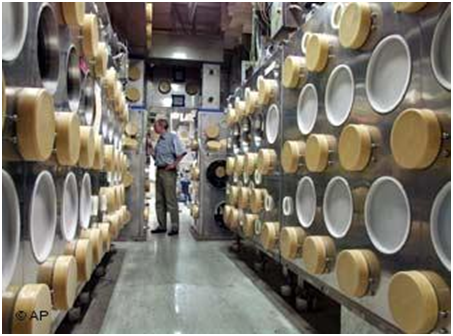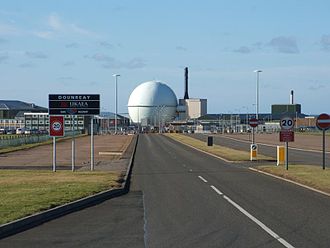
Blog
-
Geiger Readings for February 14, 2013
Ambient office = 82 nanosieverts per hourAmbient outside = 98 nanosieverts per hourSoil exposed to rain water = 81 nanosieverts per hourRed bell pepper from Top Foods = 75 nanosieverts per hourTap water = 89 nanosieverts per hourFiltered water = 56 nanosieverts per hour -
Radioactive Waste 58 – Illegal Nuclear Waste Dumping in Russia 1
Today, I am going to focus on illegal nuclear waste dumping inside Russia. For years, Rosatom, the government owned nuclear company in Russia, has denied that the nuclear waste reprocessing facility Mayak in the Urals is continuing to illegally dump byproducts of reprocessing into the Techa river, an important source of water for thousands of homes in the area.
Mayak is in the closed nuclear town of Ozersk. The Soviet Union built whole cities to house the scientists and workers for specific industries. These “closed” towns were off limits for foreigners and even Russians without proper documentation. Mayak is the only facility in Russia that can reprocess the nuclear fuel used in the VVER-440 reactors and spent fuel from Russian submarines.
In 1957, a waste storage tank exploded at Mayak. Radioactive materials were spread across the region and hundreds of thousands of residents had to be evacuated. The Soviet nuclear authorities claimed that a reactor had exploded in the nearby town of Kyshtym to divert attention from the real site and nature of the accident. Many people in the area were forced to work on the clean-up with little protection against the radiation.
Rosatom has been claiming that Mayak stopped dumping toxic wastes into the river decades ago. Russian court documents prove that this practice has never stopped. The release of deadly nuclear waste into the Techa river and the nearby Lake Karachai over many decades has resulted in this area being designated as one of the most radioactive contaminated places in the whole world.
In 2006, the director of Mayak was relieved of his duties and charged with criminal activity in regard to the continued dumping of nuclear wastes into the Techa. It took five years for activists to obtain court documents for the closed hearings. The court documents state that between 2001 and 2004, over a billion cubic feet of nuclear waste was dumped into the Techa in clear violation of Russian law.
Testing of the river water indicated that it qualified as “liquid radioactive waste.” The five thousand residents in the area suffered increase levels of acute myeloid leukemia and other forms of cancer as a result of the radioactive contamination of their environment. The area around the river was eighty times the normal level of background radiation. The radioactive contamination has spread from the water through the food chain to the human residents of the area.
Between 2001 and 2004, the managers of Mayak received over one hundred and seventy million dollars, mostly from accepting nuclear waste shipments from abroad as mentioned in my previous post. Apparently none of the money was used to make the storage of nuclear waste any safer. Instead, it was spent on unrelated business expenses. In 2006, the court found that five villages in the area had been contaminated by recent dumping at Mayak. Over the lifetime of Mayak, as much as fifteen billion cubic feet of radioactive waste has been dumped into the Techa river.
Rosatom has repeatedly claimed that Mayak is a ” model industrial enterprise that does no damage to the environment.” The recent testing and court cases show that their claims are lies and they know they are lying. Fortunately, with the finding of the court case in 2006, there have been calls for such measures as covering the Techa river with a concrete lid and making certain that all dumping of wastes into the Techa river are stopped.
Mayak nuclear plant:
-
Geiger Readings for February 13, 2013
Ambient office = 96 nanosieverts per hourAmbient outside = 55 nanosieverts per hourSoil exposed to rain water = 57 nanosieverts per hourRed seedless grapes from Top Foods = 70 nanosieverts per hourTap water = 83 nanosieverts per hourFiltered water = 78 nanosieverts per hour -
Radioactive Waste 57 – Illegal Nulcear Waste Dumping in Sweden
Nukem, a private company, operates a facility at Hanau on the River Kinzig in central Germany which concentrated uranium ore and filled fuel tubes with the concentrate for nuclear reactors. Nukem is involved in supplying nuclear fuel to reactors in North and South America, Europe and Asia. It has grown into one of the biggest intermediaries in nuclear fuel in the world. Forty tons of waste generated at Hanau was shipped to Sweden by Westinghouse Atom AB for recovery of residual uranium at Ranstad Mineral AB’s uranium processing plant.
Vasteras was a Swedish company formed in 1969 as a partnership between ASEA, a private company and the Swedish government. Eventually, Vasteras bought out the state share of the partnership in the early 1980s. It merged with Brown Boveri, another Swedish company to become ABB Atom, part of the worldwide company group known as ABB. In 2000, ABB Atom was sold to Westinghouse and renamed Westinghouse Atom AB.
The Swedish Parliament has passed strict laws prohibiting the importation of nuclear waste into Sweden from other countries. The waste from Hanau was allowed in because it contained what were classified as “useful residues.” Following the extraction of the uranium, the remaining waste was dumped into the Risangen municipal dump site near the town of Skovde.
In 2000, tests by the Swedish Radiation Protection Institute (SSI) confirmed that the radiation in the remaining waste deposited in the Risangen dump exceeded what the Swedish government considers a safe level and further dumping of such waste at Risangen was prohibited. SSI investigated whether Westinghouse Atom AB, the transporter of the Hanau waste, had “penal responsibility” for breaking the Radiation Protection Law. SSI decided that that the dumping of the processed waste at Risangen was only a minor breach of the law and did not rise to “penal responsibility. SSI said that there was no danger to the environment or public health.
Westinghouse Atom AB claims that it did not know that the waste exceeded the Swedish limit. This is difficult to believe given the long history of Westinghouse in the global nuclear industry. Apparently Westinghouse did not test the waste that was leaving the reprocessing plant bound for the municipal dump because they certainly have the technical capability. Since the SSI decided that Westinghouse Atom AB was only guilty of a minor infraction that did not rise to “penal responsibility”, if there are any future costs or dangers associated with the radioactive contamination of the Risangen dump, they will be born by the citizens of Sweden and especially those in the area of Skovde. Once again, a government agency has given a private company a pass for incompetence at the least and intentional breaking of Swedish law at the worst.
Plutonium tablets stored at Hanau nuclear facility:
-
Radiation News Roundup February 12, 2013
There is a new source of leakage at Fukushima. enenews.com
A small earthquake right under the Fukushima reactors could be very destructive. voiceofrussia.com
The pouring of first concrete has marked the official start of construction of Argentina’s prototype CAREM-25, a domestically-designed and developed small integral reactor. world-nuclear-news.com
-
Geiger Readings for February 12, 2013
Ambient office = 75 nanosieverts per hourAmbient outside = 83 nanosieverts per hourSoil exposed to rain water = 116 nanosieverts per hourVine ripened tomato from Top Foods = 119 nanosieverts per hourTap water = 100 nanosieverts per hourFiltered water = 86 nanosieverts per hour -
Radioactive Waste 56 – Illegal Nulcear Waste Dumping in England 2
In 2007, The United Kingdom Atomic Energy Authority (UKAEA) pled guilty to four counts of illegal dumping of nuclear waste. The UKAEA was created in 1954 by the UK government. It was charged with responsibility for the entire UK nuclear program, including military and defense. It was also given authority over all nuclear sites in the UK. The UKAEA advanced nuclear technology and the use of nuclear power for peaceful purposes. In the 1970s, the UKAEA began turning over different aspects of its work to other government agencies and to private firms. Currently, the UKAEA has primary responsibility for nuclear fusion research in the U.K.
The illegal dumping occurred at Dounreay while it was under the authority of the UKAEA. Dounreay is located on the north coast of Caithness, in the Scottish Highlands. There are ruins of a castle in the area. Since the 1950s, Dounreay has been the location of several nuclear research laboratories. A prototype fast breeder reactor was built there and nuclear submarine engines were also developed there. Most of these facilities have either been decommissioned or are in the process of being decommissioned.
The Scottish Environmental Protection Agency issued a report that revealed illegal dumping that took place between 1963 and 1984. The UKAEA was charged with illegally dumping solid nuclear waste in a land fill at Dounreay. Three other charges were that the UKAEA allowed irradiated fragments of nuclear fuel to enter the liquid effluent pipes that carried water from the plant to the Pentland Firth which is a strait that separates the Orkney Islands from Caithness. The UKAEA pled guilty to all four charges.
The lawyer for UKAEA admitted that the dumping and discharges should not have happened. He said that “mistakes were made” during the early years of fast breeder research. This is a serious understatement when the global record of fast breeder research is examined. Japan is just in the process of shutting down its fast breeder reactor at Monju because of many problems. The old Rocketdyne site in southern California is still contaminated with the results of “mistakes” in their fast breeder program from decades ago.
Sentencing was deferred after the prosecutors discussed the situation with financial officials from UKAEA. The UK taxpayers will have to pick up the cost of dealing with the contamination that resulted from UKAEA activities. This is another example of a government agency carrying out illegal activities that UK taxpayers must pay for. This situation can be found many times when studying the early years of nuclear research in the world’s nuclear nations. Often, it has been excused on the basis of the necessity of cutting corners in the nuclear arms race of the Cold War. Be that as it may, many organizations both public and private as well as many individuals have escaped responsibility or penalty for such illegal activities.
Dounreay nuclear site:
-
Radiation News Roundup February 11, 2013
Radioactive substances that wash up on beaches can enter the fresh water supply. enenews.com
Scientist surprised at how much higher radiation levels are in some parts of ocean far from Fukushima. enenews.com
The US Nuclear Regulatory Commission (NRC) has given its blessing to uprates at five nuclear reactors that will add nearly 100 MWe of capacity to the US grid. world-nuclear-news.com
-
Geiger Readings for February 11, 2013
Ambient office = 95 nanosieverts per hourAmbient outside = 101 nanosieverts per hourSoil exposed to rain water = 120 nanosieverts per hourVine ripened tomato from Top Foods =92 nanosieverts per hourTap water = 94 nanosieverts per hourFiltered water = 85 nanosieverts per hour






